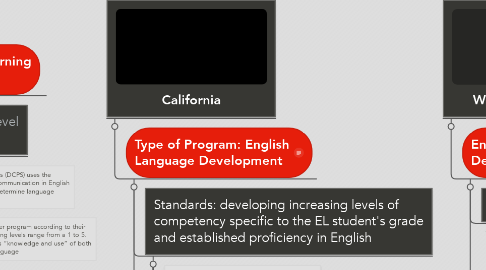
1. California
1.1. Type of Program: English Language Development
1.1.1. Standards: developing increasing levels of competency specific to the EL student's grade and established proficiency in English
1.1.1.1. Collaborative—participating in conversations, expressing thoughts/feelings/opinions in a variety of contexts
1.1.1.2. Interpretive—understanding vocabulary, linguistic nuances and cultural contexts
1.1.1.3. Productive—producing and initiating increasingly complex levels of spoken and written English tailored to a specific audience.
1.1.1.4. Metalinguistic Awareness—understanding differences between English and native language, adapting situationally appropriate language
1.1.1.5. Accuracy of Production—overall comprehensibility and decreasing errors
1.1.2. Objectives: overarching goals for ELL learners during and after program implementation
1.1.2.1. Mastery of specific skills determined by level of proficiency
1.1.2.1.1. Emerging
1.1.2.1.2. Expanding
1.1.2.1.3. Bridging
2. Washington, DC
2.1. English Language Learning Programs
2.1.1. Language Ability/Level Determination
2.1.1.1. District of Columbia Public Schools (DCPS) uses the Assessing Comprehension and Communication in English State to State (ACCESS) tests to determine language ability
2.1.1.2. DCPS places students in the proper program according to their ACCESS score. The ACCESS scoring levels range from a 1 to 5. Each level focuses on the students “knowledge and use” of both social language and academic language
2.1.2. ACCESS Scoring
2.1.2.1. The ACCESS levels are as follows:
2.1.2.2. 1. Entering – minimal knowledge and use of language
2.1.2.3. 2. Beginning – knowledge and use of some social language and general academic language
2.1.2.4. 3. Developing – knowledge and use of social language and some specific academic language
2.1.2.5. 4. Expanding – knowledge and use of social language and some technical academic language
2.1.2.6. 5. Bridging – knowledge and use of social language and academic language with modified grade-level material
2.1.3. Language Program Outcome
2.1.3.1. The tests measure four areas: listening, speaking, reading and writing. The test’s measurements are conducted across multiple content areas, to include: social and instructional English, language arts, math, science and social studies.
2.1.3.2. DCPS expects that once a student reaches level 5, they are ready to meet state academic content standards with no language support services. When a student achieves a level 5 score, DCPS exits them from the program.
3. Washington State
3.1. English Language Proficiency Development Program
3.1.1. Standards
3.1.1.1. Every ELL student has the same potential as native speakers of English. All students, regardless of level, need access to challenging, grade appropriate curriculum.
3.1.1.2. The primary language and cultural background of ELL students are useful tools in the learning process. Awareness of culture should be embedded in the curriculum and instruction provided to ELL students.
3.1.1.3. A student's ELP level represents a current performance, not a fixed status.
3.1.1.4. Scaffolding should be used at all levels of ELP in order to reach the next reasonable proficient level.
3.1.1.5. Students with limited or interrupted formal education must have access to supports that will allow them to develop skills at an accelerated rate.
3.1.1.6. Language development should be included in the IEPs of ELL students in the SPED program.
3.1.1.7. All ELLs, regardless of disabilities, should have access to accommodations and supports for assessments so that their assessment results are valid and reflect their current performance.
3.1.1.8. Relevant and appropriate multimedia tools should be fitted to the ELP standards and integrated into the curriculum, instruction, and assessment of ELLs.
3.1.2. Student Objectives
3.1.2.1. By the end of each ELP level, an ELL can...
3.1.2.1.1. Level 1
3.1.2.1.2. Level 2
3.1.2.1.3. Level 3
3.1.2.1.4. Level 4
3.1.2.1.5. Level 5
